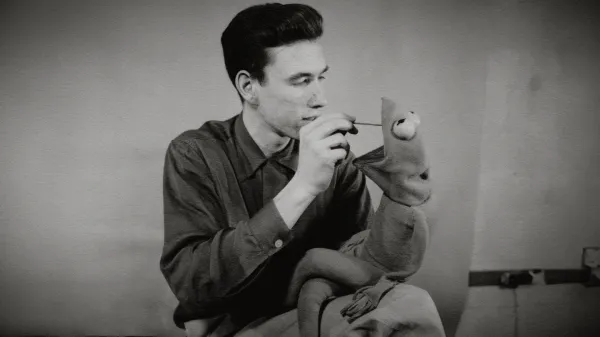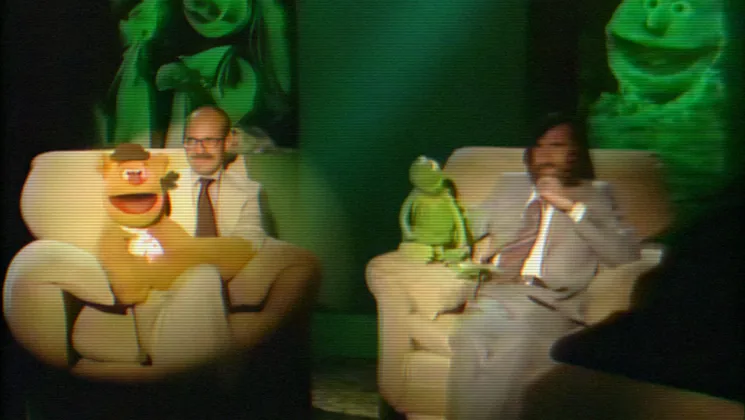Jim Henson looms large in my childhood. As an artist, he is probably more responsible for shaping my idea of what art is, helping me understand that high art and low art are labels that mean nothing. To say nothing of the love and care that went into his work that mirrored the love and care he put out into the world.
Ron Howard’s documentary Jim Henson Idea Man is tailor-made for people like me. It’s more a loving tribute than a documentary. The title is a bit of a misnomer, the process of how Henson breathed life into these ideas is largely overlooked. The documentary is instead of friends, co-workers, and family members coming together to try and paint a picture of this towering figure who was intensely shy and introverted.

Howard’s documentary tries not to look at Henson with rose-colored glasses. Ultimately it is an impossible feat seeing as how everyone interviewed is in awe of the great man’s genius. However, to Howard’s credit, he does his best to paint a picture of a complicated man. Whether it’s how he and his wife Jane had different views of what a marriage is or how his kids early on had to share their father with his work, Henson comes off more flesh and blood than we usually think of him.
For myself, I was fascinated by the fact that Henson was reluctant to join the Children’s Workshop. Despite his affinity for puppetry, he never saw himself as a children’s entertainer. Yet, he recognized the beauty of the PBS notion: What if TV loved people instead of trying to sell to them? An ethos that Henson himself seems to gravitate towards in his work.
Yes, he wanted to make money, but the art was always more important to him. At heart, he was an experimentalist. I was fascinated to learn that at one point after Sesame Street had hit it big, and before selling The Muppet Show, Henson had toyed with designing nightclubs. Or more specifically wanting to design nightclub spaces but infusing experimental light arrays, art installations, and multi-sensory dance and music areas.
Ironically, it’s not the stuff about Henson that sheds the most light on him. It’s the stuff about Frank Oz and his wife Jane. Learning about the type of people that Jim gravitated to, and hearing their thoughts and ideas about him, was in a way, more enlightening than any expose. Frank and Jane were both opposites to Jim, but both contained necessary qualities that he saw as vital to success. Jane, more than a wife, was often invested in the business and art. She and Jim started out together, and her anarchic sensibilities influenced Jim a young Christian Scientist from rural Mississippi.
It’s the stories about people like Lord Lew Grade, the man who bought Henson’s The Muppet Show that shine the most light on Henson. Finding out about the world he inhabited and the colorful characters that inhabited that world, act like a cipher to a man who to this day seems so strangely enigmatic.
Oz, unlike Jim, came from a family of professional puppeteers. As one of the talking heads opines, “Frank’s parents took puppetry so seriously Frank had no choice but not to take it seriously.” Jim’s impishness and Frank’s seriousness mirrored a couple that would become staples on Sesame Street, Burt & Ernie.
Oz shares how he thought of Miss Piggy as someone who wanted desperately to be famous but also knew she had no talent. I had never viewed Miss Piggy as a failure. But listening to Oz it became clear that, for Oz, much of Piggy’s bravado came from her very real fear of failure. Iit put Miss Piggy in a new light for me, which is inedible. That these characters who have existed since the 70s can still reveal depths you never knew or thought about.
Jim Henson Idea Man, while it talks a lot about his early days toiling in commercials, the footage they show is nothing we haven’t seen in other Henson biographies. On YouTube you can find a series of training films Jim did for IBM salesman in the 60s starring Rowlf the Dog. These shorts show the sharpness of Henson’s mind as well as his ability to take any gig and find the truth in it even if it was just a paycheck. Something Howard and his team get across but do so almost clumsily.
The problem with a Jim Henson documentary is how do you get inside a notoriously private man. The answer is you use a cavalcade of behind-the-scenes footage, old commercials, snippets from home movies, and talk to his close friends and family using a small army of cinematographers and editors. Jim Henson Idea Man is a surprisingly frenetic piece of documentary filmmaking.
Howard and his team create collages and montages of personal photos and the subjects they are interviewing. Along with this Howard sets many of the interviews in a digitized cube, with each square containing a piece of an image or several smaller images. Howard is attempting to stay true to Henson’s experimental spirit.
While Howard is professional and competent, he is not known for his experimentalism. The result is that Jim Henson Idea Man is a mixed bag. It’s easy on the eyes, but the visuals also feel safe, as if Howard wanted to appear to take chances but not actually take them. Jim Henson Idea Man feels kinetic but also never draws us in.

Jim Henson Idea Man serves as an introduction to Jim Henson with a few little-known bon-mots amongst a slew of commonly known oft-repeated facts.
It’s the moments like Jim and Frank on The Orson Welles Show with Kermit and Fozzie by their side, respectively, that are the highlight of the documentary. The look on Henson’s face as he looks at Orson Welles, one of the most infamous experimenters, is by itself one of the great insights into what makes Henson tick. There’s something about seeing a grown man, one that you admire, beside himself with giddiness and awe that is deeply humanizing.
I wouldn’t call Howard’s ode to Henson ineffective. Towards the end when they showed Henson’s Memorial service I found myself crying as Big Bird sang “It’s Not Easy Being Green”. This is not a difficult feat as that moment always makes me cry.
Still, when Jim Henson the Idea Man talks about the impact of “It’s Not Easy Being Green”, everyone tries really hard to allude to the racial undertones of what makes the song so resonant to so many people without ever outright saying it. It’s an awkward moment because people suddenly start watching what they say about a song that, as much as “The Rainbow Connection”, lives in the hearts and minds of generations of people. But neither Howard nor anyone else wants to get too political or even broach the topic of race.
For a documentary about a man who valued experimentalism, Howard doesn’t seem up to the task. I can’t imagine anyone who isn’t already some sort of Henson fanatic being interested in Jim Henson Idea Man. On some level, Howard senses this as he tries to keep the documentary focused on Jim Henson trivia and anecdotes. The result is a tight documentary but by the end, we don’t feel as if we know Jim Henson anymore than when we started.
Images courtesy of Disney +
Have strong thoughts about this piece you need to share? Or maybe there’s something else on your mind you’re wanting to talk about with fellow Fandomentals? Head on over to our Community server to join in the conversation!

